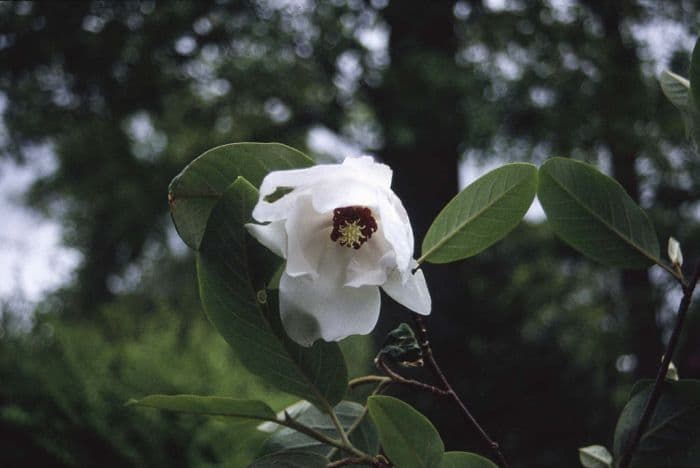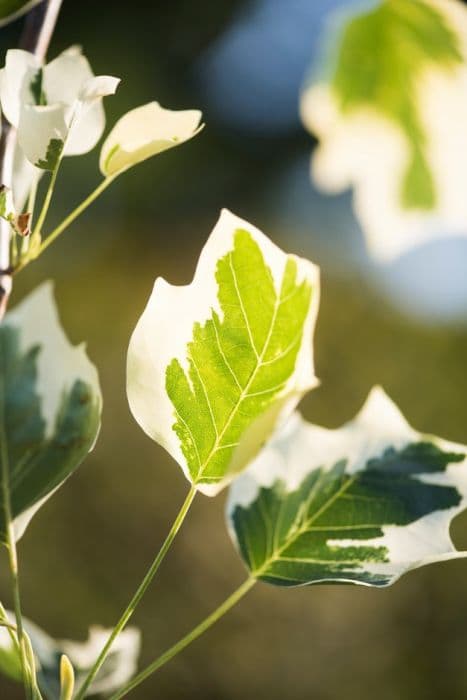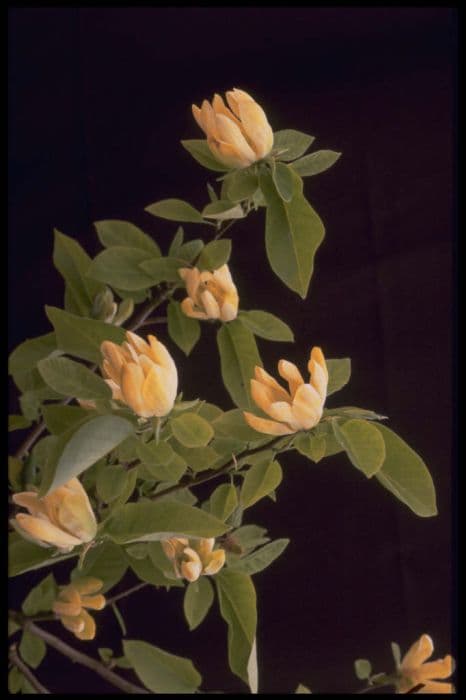Wilson's Magnolia Magnolia wilsonii

ABOUT
Magnolia wilsonii, commonly known as Wilson's magnolia, is a plant with a distinctly elegant appearance. This plant produces creamy-white flowers that are deeply cup-shaped and feature a set of prominent, crimson stamens at the center, adding a striking contrast. The flowers are known for their sweet fragrance that perfumes the air around them. Each bloom is pendulous, often nodding on their stems, which gives the plant a graceful and somewhat weeping profile. The leaves of Wilson's magnolia are lush and green, providing a beautiful backdrop for the flowers. They are elongated oval in shape and have a slightly leathery texture with a smooth, glossy surface that catches the light. These leaves can turn a golden-yellow color in the fall, bringing a seasonal display of warmth and color. After the flowering period, Wilson's magnolia produces seed cones that are quite impressive visually. These fruiting bodies elongate and display seeds that have a bright reddish-orange aril, which is the fleshy covering around the seed. The contrast between these seeds and the cones, together with the overall foliage, contributes to the plant's ornamental value beyond its blooming season. Overall, the appearance of Wilson's magnolia is one of subtlety and refined beauty, with its pendulous flowers, rich foliage, and eye-catching seeds creating a picturesque addition to any setting where they are grown.
About this plant
 Names
NamesFamily
Magnoliaceae
Synonyms
Wilson's Magnolia, Siebold's Magnoliat
Common names
Magnolia cavaleriei var. wilsonii, Michelia wilsonii, Yulania wilsonii
 Toxicity
ToxicityTo humans
Magnolia wilsonii, commonly known as Wilson's magnolia, is not widely recognized as a toxic plant to humans. There is limited information regarding its potential toxicity when ingested. As with many plants, individual sensitivities can vary, so it is generally advisable to avoid consuming parts of ornamental plants like the Wilson's magnolia due to the risk of gastrointestinal discomfort or allergic reactions. If ingestion occurs and there are concerns about poisoning, it is recommended to seek medical advice.
To pets
Wilson's magnolia is generally not considered toxic to pets. However, as with any plant not typically part of an animal's diet, ingestion of its parts could potentially lead to gastrointestinal upset such as vomiting or diarrhea in sensitive pets. If a pet shows signs of distress after ingesting any part of the Wilson's magnolia, it is best to consult a veterinarian.
 Characteristics
CharacteristicsLife cycle
Perennials
Foliage type
Deciduous
Color of leaves
Green
Flower color
White
Height
10-15 feet (3-4.5 meters)
Spread
6-10 feet (1.8-3 meters)
Plant type
Tree
Hardiness zones
7
Native area
China
Benefits
 General Benefits
General Benefits- Aesthetic Appeal: Magnolia wilsonii, commonly known as Wilson's magnolia, has large, attractive white flowers with a striking red center, making it a visually appealing addition to gardens.
- Fragrance: The flowers emit a pleasant, sweet fragrance that can enhance the sensory experience of a garden or outdoor space.
- Shade Providing: With its broad canopy, Wilson's magnolia can provide ample shade, creating a cool, sheltered area during warm months.
- Habitat for Wildlife: The tree can serve as a habitat for various species of birds and insects, contributing to local biodiversity.
- Ornamental Value: Wilson's magnolia is often used as a specimen plant due to its distinct flowers and overall form, offering high ornamental value to landscapers and garden designers.
- Year-Round Interest: Throughout the seasons, Wilson's magnolia provides visual interest with its spring blooms, lush summer foliage, and textured bark in autumn and winter.
 Medical Properties
Medical PropertiesThis plant is not used for medical purposes.
 Air-purifying Qualities
Air-purifying QualitiesThis plant is not specifically known for air purifying qualities.
 Other Uses
Other Uses- Magnolia wilsonii, commonly known as Wilson's magnolia, can be used as a natural dye source, producing soft yellow or green hues on fabric when the leaves or flowers are processed.
- The bark of Wilson's magnolia has been traditionally used in woodworking and crafting due to its decorative patterns and unique texture.
- Landscape artists and garden designers use Wilson's magnolia as a specimen plant to create visually striking focal points in gardens and parks.
- The wood of Wilson's magnolia is sometimes used in the production of small wooden objects like boxes, inlays, or even musical instruments because of its workability and fine grain.
- Wilson's magnolia petals can be used in culinary presentations as a delicate garnish that adds elegance to fine dining dishes.
- Fallen leaves of Wilson's magnolia can be gathered and used as a natural mulch, providing soil enrichment and moisture retention for garden beds.
- The seed cones of Wilson's magnolia can be collected and used in decorative floral arrangements or as part of arts and crafts projects.
- This plant's dense foliage offers a natural privacy screen or windbreak when planted in rows or clusters in residential or commercial landscapes.
- Photographers and artists might seek out Wilson's magnolia for its aesthetic appeal, incorporating its flowers and structure into their visual compositions.
- The plant can also play a role in educational settings, where students can study its growth patterns, floral biology, and ecological importance.
Interesting Facts
 Feng Shui
Feng ShuiThe Wilson's Magnolia is not used in Feng Shui practice.
 Zodiac Sign Compitability
Zodiac Sign CompitabilityThe Wilson's Magnolia is not used in astrology practice.
 Plant Symbolism
Plant Symbolism- Purity: The magnolia's white flowers are often associated with purity, reflecting its striking and unblemished appearance.
- Dignity: Magnolias are known to symbolize dignity, possibly due to their grand and upright form.
- Persistence: With magnolias being ancient plants that have existed for millions of years, they represent endurance and long life.
- Nobility: In some cultures, the magnolia is considered a noble flower, imbued with a quiet but assertive elegance.
- Feminine beauty: The magnolia is frequently connected to the beauty and softness of femininity, celebrating the graceful aspects of womanhood.
 Water
WaterWilson's Magnolia prefers evenly moist soil, so it should be watered deeply once a week, providing about 1.5 gallons of water each time. This frequency should increase to twice a week during hot, dry periods. Make sure to water directly at the base of the plant, avoiding overhead watering to prevent fungal diseases. During winter or cooler months, you can reduce watering as the plant's water requirements decrease. Always check the top few inches of soil for dryness before watering to prevent overwatering.
 Light
LightWilson's Magnolia thrives in partial shade to full sun. The ideal location would offer morning sunlight and afternoon shade, especially in areas with hot summers. Positioning them in a spot that gets dappled sunlight throughout the day is also beneficial to avoid scorching the leaves while ensuring enough light for healthy growth.
 Temperature
TemperatureWilson's Magnolia is hardy and can tolerate a range of temperatures; however, it grows best when the temperature is between 60°F and 80°F. It can withstand minimum temperatures down to about -10°F and maximum temperatures up to 95°F. To ensure optimal growth, avoid placing it in areas where temperatures can fluctuate wildly or where cold drafts might occur.
 Pruning
PruningPruning Wilson's Magnolia should be done to remove dead or damaged branches, maintain shape, and encourage healthy growth. The best time to prune is in late winter or early spring before new growth begins. Prune sparingly and cut back to just above a set of leaves or a branch junction. It is not necessary to prune every year; instead, observe the plant's shape and health to determine the need for pruning.
 Cleaning
CleaningAs needed
 Soil
SoilWilson's Magnolia thrives in moist, well-drained, acidic soil with a pH range of 5.5 to 6.5. A good soil mix consists of two parts peat moss, one part compost, and one part perlite to ensure proper drainage and fertility.
 Repotting
RepottingWilson's Magnolia should be repotted every 2-3 years to ensure it has enough room for root growth and to replenish soil nutrients.
 Humidity & Misting
Humidity & MistingWilson's Magnolia prefers high humidity levels, ideally between 50-60% for optimal growth.
 Suitable locations
Suitable locationsIndoor
Place Wilson's Magnolia in bright, indirect light with high humidity.
Outdoor
Plant Wilson's Magnolia in partial shade and shelter from wind.
Hardiness zone
7-10 USDA
 Life cycle
Life cycleMagnolia wilsonii, commonly known as Wilson's magnolia, begins its life as a seed, often dispersed by the wind or animal vectors. Upon finding suitable soil, it germinates, typically in the spring, and a seedling emerges, initially relying on the energy stored within the seed. The seedling grows into a juvenile plant, developing a deep root system and foliage, entering the vegetative stage where it focuses on growth and survival. As the plant matures, it enters the reproductive stage; Wilson's magnolia is known for its large, fragrant white flowers with a red center, which attract pollinators and appear in late spring to early summer. After pollination, the flowers develop into cone-like fruit that releases red seeds, continuing the reproductive cycle. Over many years, the magnolia can grow into a sizeable tree, reaching maturity and potentially living for several decades, during which it will flower and set seed annually.
 Propogation
PropogationPropogation time
Spring-early summer
The most popular method of propagating Magnolia wilsonii, commonly known as Wilson's magnolia, is through seed. Seeds should be collected as soon as they ripen in autumn and then sown immediately in a cold frame as they have a short viability period. The seeds have a fleshy, organic seed coat that must be removed before sowing, as it inhibits germination. Once cleaned, sow the seeds in a well-drained seed-raising mix at a depth of about 1/4 inch (around 6 millimeters). The seeds require a period of cold stratification to break dormancy; thus, leaving them in the cold frame over winter should provide the necessary conditions. Germination often occurs in the spring as temperatures rise, and once the seedlings are large enough to handle, they can be potted up into individual containers to grow on before transplanting them into their final position in the garden.





![Magnolia [Fairy Blush]](/_next/image?url=https%3A%2F%2Fplants-admin.emdemapps.com%2Fimages%2Fplants%2F%2Fimages%2F604b5a108e959.png&w=640&q=75)



